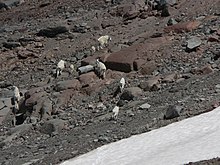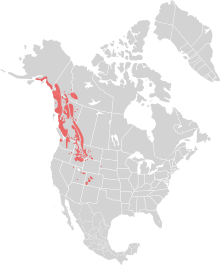Mountain goat
| Mountain goat | ||||||||||||
|---|---|---|---|---|---|---|---|---|---|---|---|---|

Mountain goat |
||||||||||||
| Systematics | ||||||||||||
|
||||||||||||
| Scientific name of the genus | ||||||||||||
| Oreamnos | ||||||||||||
| Rafinesque , 1817 | ||||||||||||
| Scientific name of the species | ||||||||||||
| Oreamnos americanus | ||||||||||||
| ( de Blainville , 1816) |

The snow goat ( oreamnos americanus ), even mountain goat called, is one in the mountainous regions of North America -based mammalian species from the group of caprine (Caprini).
features
Mountain goats reach a head body length of 120 to 160 centimeters, the tail is a 10 to 20 centimeter long stub. The shoulder height is 90 to 120 centimeters, males are 10 to 30% larger than females. The weight for females is 55 to 70 kilograms and for males 60 to 80 kilograms, in exceptional cases up to 140 kilograms. The strong body is supported by muscular legs. The big claws are adapted to life in mountain regions. The fur of mountain goats is relatively short and white in summer; in winter it becomes longer, more shaggy and more yellowish. The undercoat is thick and woolly. A hump of hair extends on the nape of the neck; both sexes have goatees. The eyes and the tip of the nose are black and contrast strongly with the white facial fur. Both sexes have black horns that are slightly arched back and 20 to 30 centimeters long.
distribution
Mountain goats are native to the northern Rocky Mountains . The natural range includes southeast Alaska , western Canada and the northwest USA (up to the states of Washington , western Montana and Idaho ). They have been introduced in some regions of the United States ( South Dakota and Colorado ). Their habitat are steep, rocky mountain regions, where they live on alpine meadows and cliffs. In summer they stay in areas up to 5000 meters above sea level, in winter they migrate down to lower regions.
Way of life
Activity times and social behavior

Mountain goats tend to be more active in the early morning and late afternoon, but they often also look for food at night. To rest, they often retreat into shallow depressions in the ground that they have dug out with their front legs. They are excellent climbers who can conquer over 450 meters in altitude in 20 minutes.
In the summer months they live in small groups of no more than four animals. Adult males, however, are loners. During this time, their territories cover an average of 23 km 2 . In winter they join together to form large herds with significantly smaller grazing areas. Compared to other even-toed ungulates , the females can be significantly more aggressive and fight against each other for territory or limited food resources.
food
The diet varies throughout the year and generally consists of grasses , leaves , coniferous leaves , mosses , lichens and other parts of plants. Salt is particularly popular in spring.
Reproduction
The mating season falls from November to January. The males then attempt to gain access to a female or group of females by approaching each other from the side. The female's fur is licked and her flanks are kicked. When the female accepts a male's efforts, they band together in a short-lived bond. During this time the male tries to keep opponents away from his female. This can also lead to aggressive fights between the males, in which they try to ram the horns into the flank of the opponent, which can cause serious, sometimes fatal injuries. After a gestation period of around 180 days, the female usually gives birth to a single young in May or June, rarely twins or triplets. The young are fleeing nests and can follow the mother within a short time. They are weaned at three to four months of age. Shortly before the birth of the next young animal, they are driven away by the mother. Sexual maturity occurs at around 2.5 years of age.
Mountain goats reach an age of 12 to 15 years in the wild, the maximum age of a female was 18 years. Life expectancy depends heavily on how the teeth wear out.
Predators
The main natural enemy is the puma . In lower lying areas, young animals in particular are also attacked by Canadian lynxes , brown bears , wolves and wolverines . The mother animals defend themselves and their young with their fighting technique often quite successfully. On the other hand, they are quite powerless when golden eagles attack their young.
Mountain goat and people
Due to the inaccessibility of their habitat, mountain goats are less affected by human influences than other North American mammals. The hunt is highly regulated and subject to the principles of wildlife management . Estimates of the total population amount to 50,000 to 100,000 animals. According to the IUCN, the species is not endangered.
Systematics
The mountain goat is the only recent representative of the genus Oreamnos . A now extinct representative, Oreamnos harringtoni , lived in the southwestern United States and northern Mexico until the Pleistocene .
Despite its name, the mountain goat is not very closely related to the actual goats (genus Capra ). Your closest living relatives among the goat-like are likely the chamois .
literature
- Ronald M. Nowak: Walker's Mammals of the World . 6th edition. Johns Hopkins University Press, Baltimore 1999, ISBN 0-8018-5789-9 (English).
- Alexander William Francis Banfield: The Mammals of Canada. University of Toronto Press, Toronto 1974, ISBN 0-8020-2137-9 .
Web links
- Information and distribution map at ultimateungulate.com
- Information at Animal Diversity Web
- Oreamnos americanus in the endangered Red List species the IUCN 2006. Posted by: Caprinae Specialist Group, 1996. Retrieved on 12 May, 2006.
Individual evidence
- ↑ Ian McT. Cowan and Wayne McCrory: Variation in the Mountain Goat, Oreamnos americanus (Blainville). Journal of Mammalogy 51 (1), 1970, pp. 60-73, doi: 10.2307 / 1378532
- ↑ Chester B. Rideout and Robert S. Hoffmann: Oreamnos americanus. Mammalian Species 63, 1975, pp. 1-6, doi: 10.2307 / 3504030


